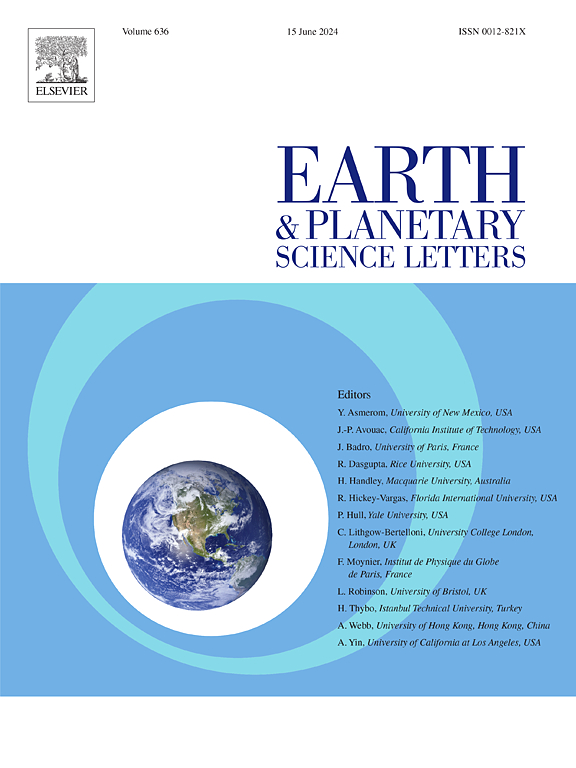Thermal evolution of the lunar magma ocean
IF 4.8
1区 地球科学
Q1 GEOCHEMISTRY & GEOPHYSICS
引用次数: 0
Abstract
The energy of the giant impact was large enough to generate an initially fully molten Moon. During the solidification of this lunar magma ocean (LMO), an anorthosite crust formed by flotation of light anorthite crystals. Lunar anorthosites show crystallization ages as young as 4.360 Gyr, suggesting a long-lived LMO or a rather young Moon. Existing models for LMO solidification are for a specific phase diagram based on one compositional model. However, the LMO solidification timescale depends on the lunar bulk composition and on the appearance of anorthite in the crystallization sequence.
Here, we propose a physically robust 1D model for LMO evolution based on a simple anorthite/olivine-pyroxene eutectic phase diagram. Cumulates first settle at the ocean base for about a thousand years. This first stage results in an unstable thermal profile for the cumulates that can lead to their overturn. In the second stage, simultaneous crystallization of anorthite and cumulates leads to the formation of a buoyant lid that considerably slows down LMO cooling.
We explore the impact of an initially hydrated composition, which reduces the stability of plagioclase, of the eutectic position and of the crust thermal conductivity. We show that cumulates overturn may reduce or extend the LMO solidification time depending on its duration. The total LMO solidification timescale ranges between 45 and 250 Myr. Given the most reliable age of 4.360 Gyr for FAN sample 60025, which derives from more than 99% of crystallization, we estimate an age of 4400 to 4560 Myr for the Moon.
月球岩浆海洋的热演化
巨大撞击的能量足以产生一个最初完全熔融的月球。在这个月球岩浆洋(LMO)的凝固过程中,轻质正长岩晶体浮选形成了正长岩地壳。月球正长岩的结晶年龄可年轻到 4.360 Gyr,这表明月球岩浆海洋或月球相当年轻。现有的 LMO 凝固模型是基于一种成分模型的特定相图。然而,LMO 的凝固时标取决于月球块体成分和结晶序列中正长岩的出现。在此,我们基于简单的正长岩/橄榄石-辉石共晶相图,提出了一个物理上稳健的 LMO 演化一维模型。积聚物首先在海洋底部沉积约一千年。第一阶段的结果是积聚体的热曲线不稳定,可能导致其倾覆。在第二阶段,正长岩和积云的同时结晶导致浮力盖的形成,从而大大减缓了 LMO 的冷却速度。我们探讨了初始水合成分的影响(它降低了斜长石的稳定性)、共晶位置和地壳导热性的影响。我们的研究表明,积聚物的倾覆可能会缩短或延长 LMO 的凝固时间,这取决于其持续时间。LMO 的总凝固时间范围在 45 到 250 Myr 之间。鉴于 FAN 样品 60025 最可靠的年龄为 4.360 Gyr(来自 99% 以上的结晶),我们估计月球的年龄为 4400 至 4560 Myr。
本文章由计算机程序翻译,如有差异,请以英文原文为准。
求助全文
约1分钟内获得全文
求助全文
来源期刊

Earth and Planetary Science Letters
地学-地球化学与地球物理
CiteScore
10.30
自引率
5.70%
发文量
475
审稿时长
2.8 months
期刊介绍:
Earth and Planetary Science Letters (EPSL) is a leading journal for researchers across the entire Earth and planetary sciences community. It publishes concise, exciting, high-impact articles ("Letters") of broad interest. Its focus is on physical and chemical processes, the evolution and general properties of the Earth and planets - from their deep interiors to their atmospheres. EPSL also includes a Frontiers section, featuring invited high-profile synthesis articles by leading experts on timely topics to bring cutting-edge research to the wider community.
 求助内容:
求助内容: 应助结果提醒方式:
应助结果提醒方式:


